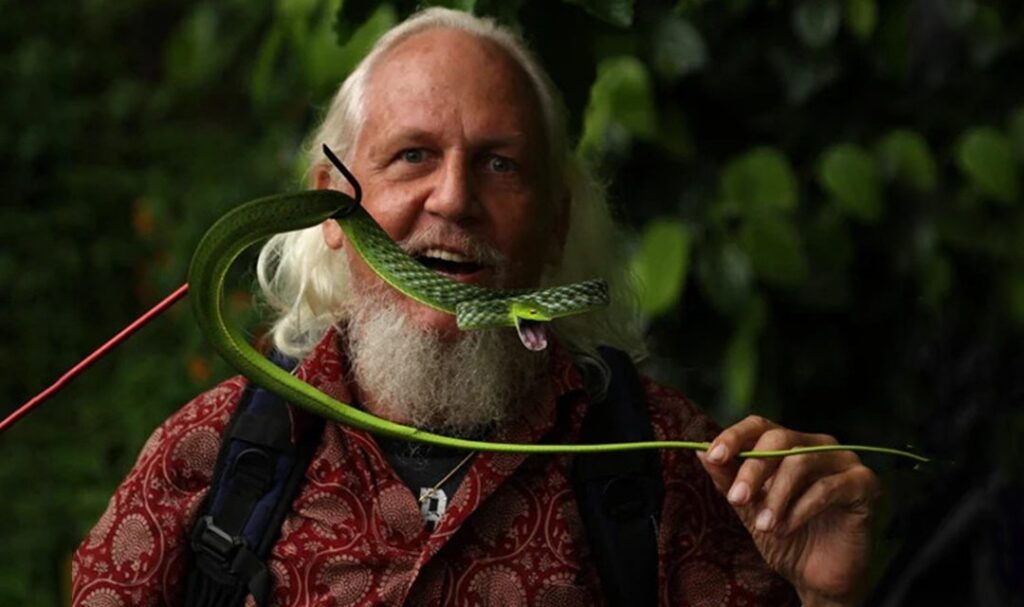The Snakeman of India: Journey from Hunter to Protector

The Snakeman of India: Journey from Hunter to Protector
Fascinating journey of Romulus Whitaker, who has dedicated his life to the study of snakes.
20 May 2024
By Khushi Maheshwari
For most children in the 1950s, moving from America to India would have been difficult, but Romulus Whitaker saw it as a dream come true because he had landed in “the land of cobras,” as he put it to CNN.
Whitaker devoted more than sixty years of his life to the study and preservation of reptiles, earning him the moniker “Snakeman of India.” In addition to founding wildlife research stations across the nation and leading a life-saving anti-venom program, he is the author of several publications on snakes.
In the end, his fieldwork with crocodiles and snakes guided his conservation efforts to preserve India’s jungles.
While elucidating how he developed an interest in snakes he said that when he initially began out as a small child in northern New York state, he would turn over rocks to locate bugs and other items. When he eventually came upon a snake, though, it was love at first sight. That was when it truly began.
However, he stated that he either thanks or blames his mother for the first time he brought a snake home. She exclaimed, “How beautiful,” amazing him. “Which mother would do it now? Not a great deal,” he continued.
The world then opened up for him when his mother married Rama Chattopadhyay and they relocated to India. “Can you imagine an eight-year-old arriving in Bombay and being able to go out into the jungles of India? These are dreams that I had when I was a little kid, which came alive,” he said.
Herpetologist Defined
He also explained what it means to be a Herpetologist and how one takes on that profession and said that a herpetologist is an odd person who specialises in studying reptiles. He claimed to have focused the most of his studies on crocodiles and snakes, but he also expressed interest in all other animals, including turtles, lizards and amphibians like toads and frogs.
Ever since he picked up his first snake at the age of four, he began doing this. He was attending an American college in 1960, but flunked out. He was later hired by Bill Haast, a gentleman who worked at the Miami Serpentarium and handled king cobras with the utmost comfort while extracting their venom.
“That was part of the love affair that I generated for king cobras. But I had always yearned to come back to India and get out to Western Ghats, where I knew king cobras still lived, and start studying them,” he said
He established the Madras Snake Park, the country’s first snake park, in 1969. They declared that they now knew more than anyone had ever known about the behaviour of king cobras and their amazing way of life.
How scary are snakes for the snakeman?
He narrated a quirky anecdote while talking about whether or not he has ever been afraid of snakes and said, “I don’t think I’ve ever been scared of a snake. I’ve been scared of myself sometimes doing stupid things. I saw a black-tailed [snake] disappearing into the bushes, and I thought, ‘ah, big rat snake.’ And I dove on it, a typical football tackle, grabbed it by the tail and suddenly this hooded snake rose up over me and I looked up and said, ‘oh no, I think I’ve caught the wrong tail.’ And I let it go. It was a king cobra, the first one I had ever found. It was scary.” He then proceeded to admit that he does get scared sometimes.
Irulas: A Rescue Story
He shed light on the existence and means of occupation and lifestyle of a native Indian tribe that they collaborated with and stated that an indigenous tribe in South India is called the Irulas. Their specialisation [was] discovering and trapping snakes for their skins; this is their area of expertise. But the ban on the snakeskin industry [in 1972] had left them with no means of subsistence. Thus, they came up with the plan to establish the Irula Snake Catchers Cooperative, a venom cooperative, in which they would capture snakes in the wild, remove their venom and then return the snakes to their natural habitat. Additionally, millions of lives were saved by using the venom to create anti-venom.
Snake bite prevention
Approximately 50,000 people die because of snake bites every year in India. A large part of Whitaker’s work focuses on raising awareness around snake bites and preventing them. He advises people to use a light while strolling around at night and make use of a mosquito net while they sleep; additionally, they must utilise sticks when working in the fields or performing agricultural tasks.
From Hunter to Conservationist
Whitaker claimed that he did not have a strong conservation mindset in his early years. Rather than observing birds, the young man with a gun would go outside and shoot them. He became a conservationist in the 1970s after realising that the situation in India had gotten out of control and that crocodiles were virtually extinct at that point.
He said that he came to the realisation that nothing would remain unless he started practising conservation. After having this realisation, he and his colleagues established field stations, which attracted a lot of people interested in working with reptiles.
“We’ve had dozens and dozens of people who have now turned out to be some of the greatest conservationists in India we can call graduates of these stations,” added Whitaker.









